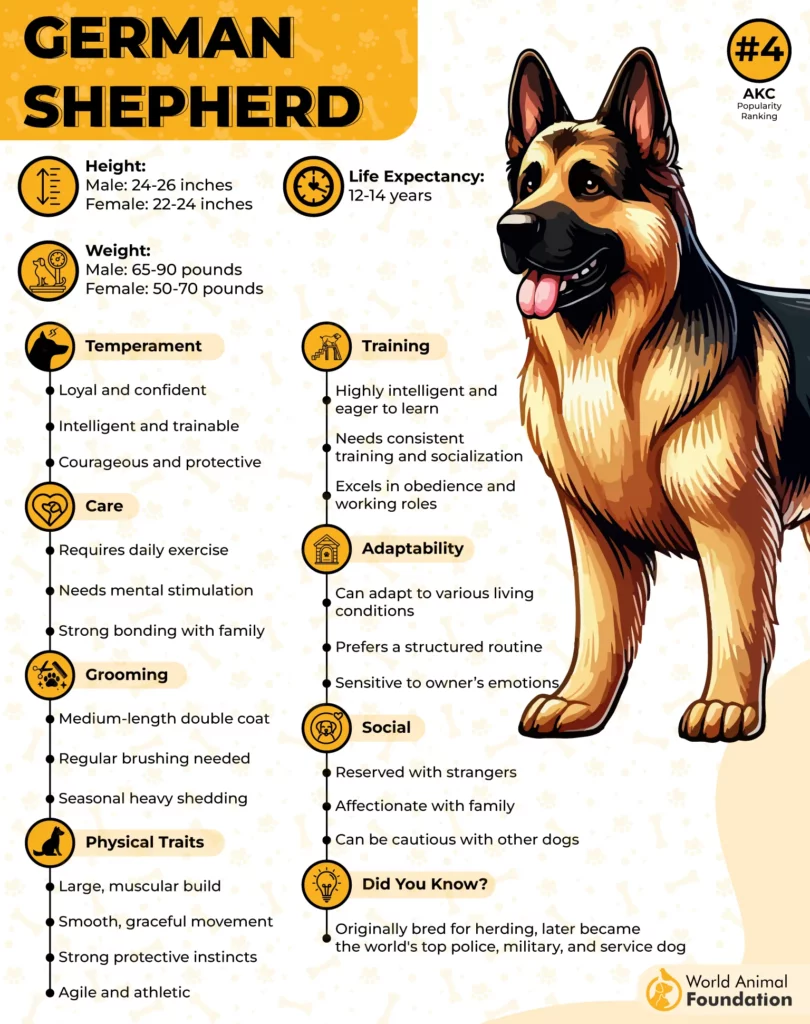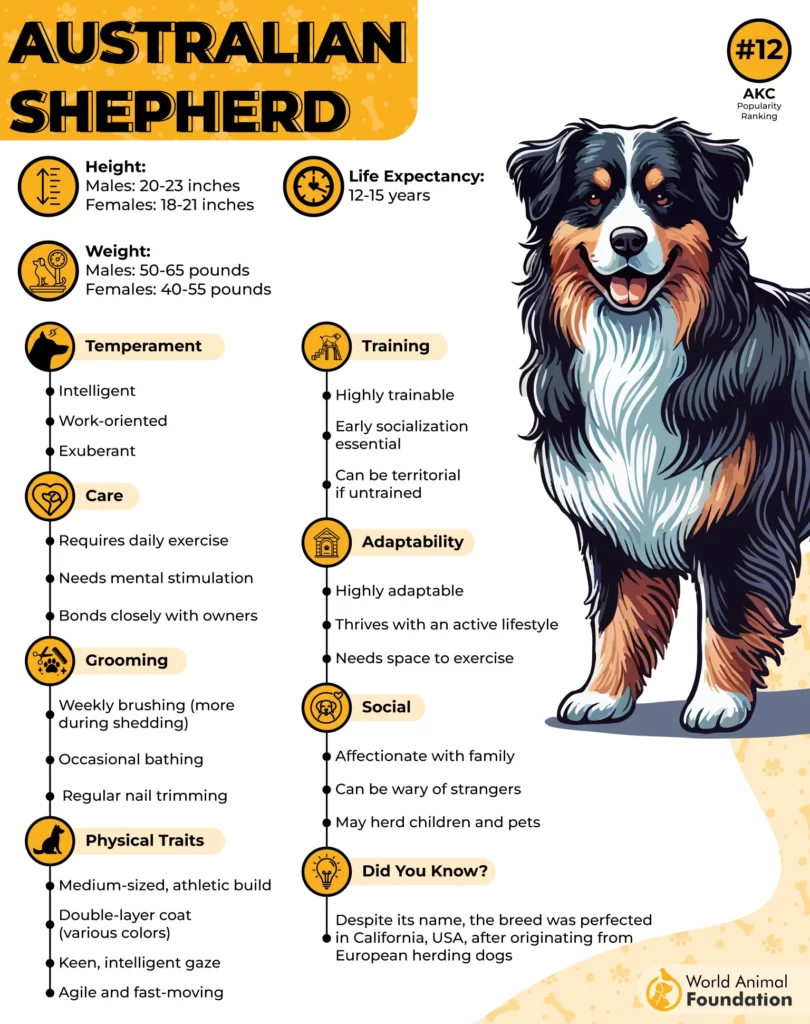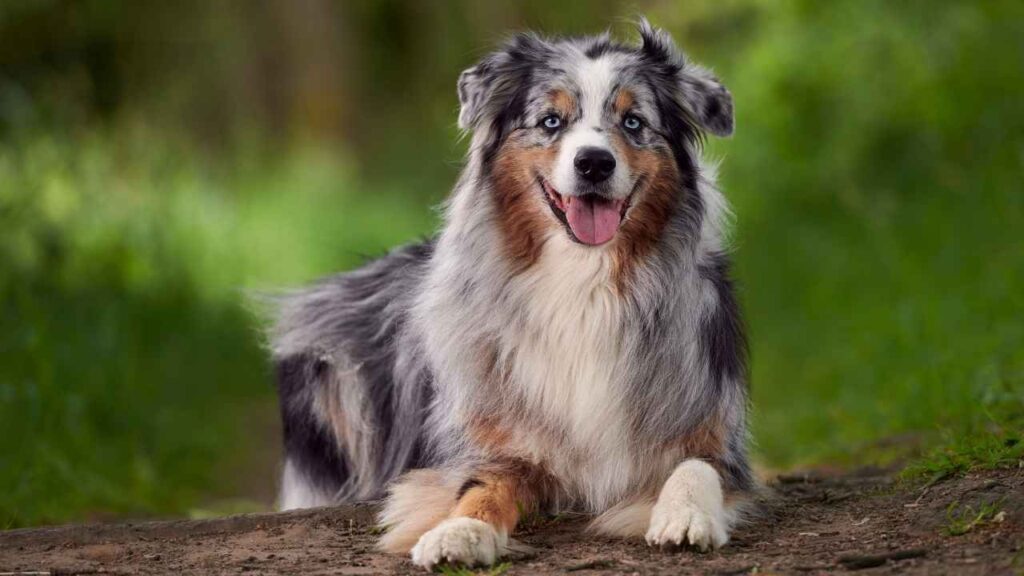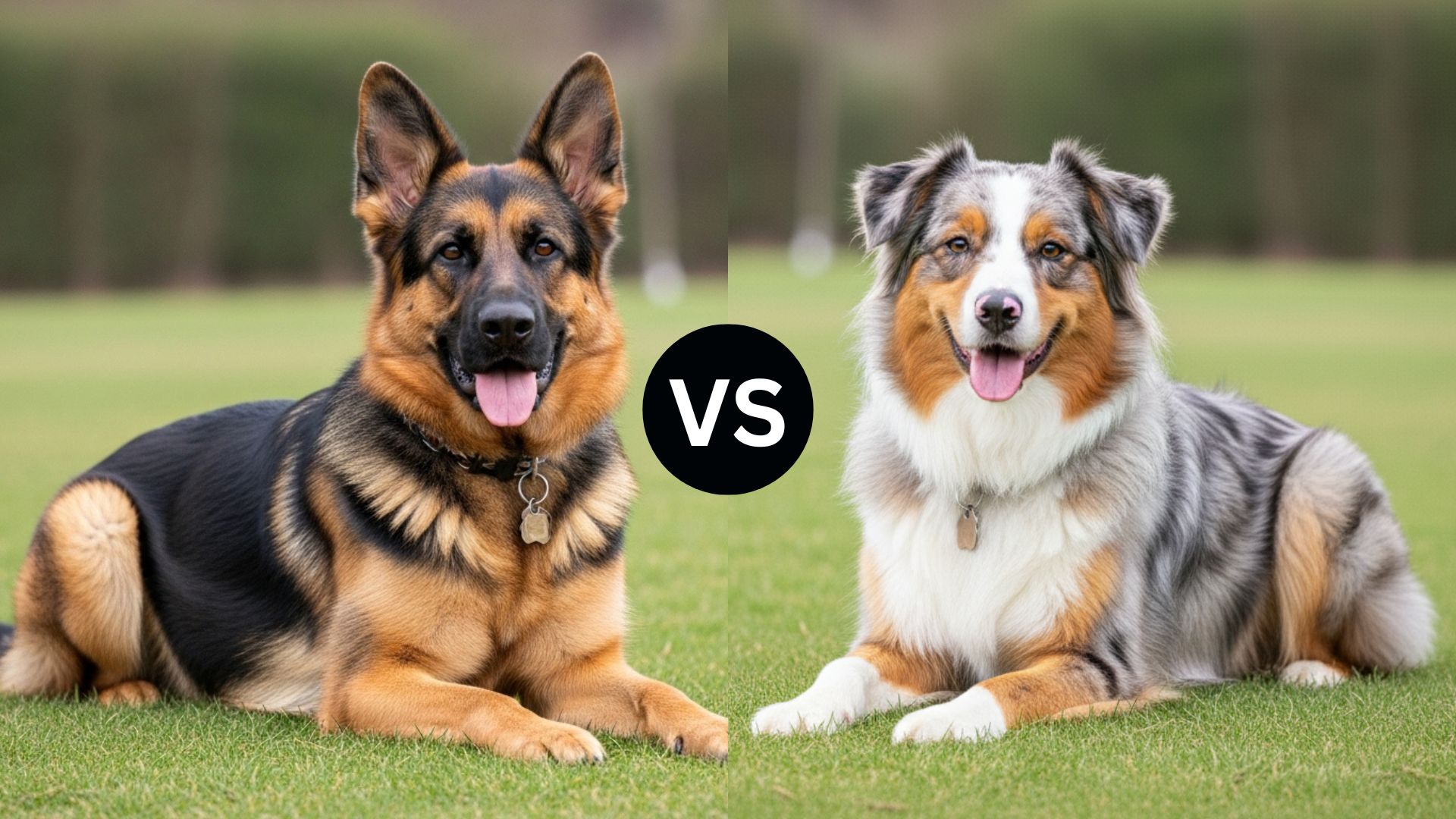Some of the smartest dog breeds on the planet are the German Shepherd and the Australian Shepherd. Both breeds are highly intelligent and possess exceptional working abilities, making them a great asset for humans.
For dog enthusiasts seeking a large, powerful dog with a majestic appearance, German Shepherds and Australian Shepherds are excellent choices.
The German Shepherd has lived alongside humans since ancient times and remains one of the most popular and recognizable dog breeds in the world. Australian Shepherds are hardworking, diligent, friendly, and free from aggression.
They can easily act as guides, and their mental abilities allow them to be trained in a wide range of commands.
While German Shepherds share similar traits, ready for work, obedient, friendly, and highly trainable, both breeds offer unique qualities. To understand their strengths better, let’s explore a deeper comparison of these remarkable dogs.
Key Takeaways
German Shepherds are ideal as service dogs, guard dogs, and working dogs due to their protective instincts and trainability.
Australian Shepherds (Aussies) are energetic, social, and thrive in active households with plenty of exercise and mental stimulation.
Both breeds have strong herding instincts, but Aussies are more playful and suited for sheep herding and family activities.
German Shepherds require experienced owners who can meet their training and socialization needs.
Choosing between the two depends on lifestyle, activity level, and desired dog temperament.
German Shepherd vs. Australian Shepherd: Dog Breeds Compared
Size & Build
German Shepherds (GSDs) are iconic large dogs with a muscular yet agile build. Adult males typically weigh between 65–90 pounds, standing 24–26 inches tall, while females are slightly smaller at 50–70 pounds and 22–24 inches in height.

Their strong, athletic frames were designed for endurance and versatility, making them excellent working dogs for herding, police, and military tasks.
Australian Shepherds, in contrast, are medium-sized dogs built for agility and stamina. They usually weigh 40–65 pounds, with males being larger than females, and stand 18–24 inches tall.

Originally bred as herding dogs, their compact, muscular bodies allow them to move quickly and respond instinctively to commands, perfect for active households or farms.
Appearance & Coat Differences
GSDs are easily recognized by their extended muzzles, tall, erect ears, and lean, muscular bodies. Their double coats, which can be short, medium, or long, come in combinations of black, tan, silver, cream, or red, often with a distinctive black saddle or mask.
Long-haired GSDs require more grooming than their short-haired counterparts, but overall, this breed is fairly low-maintenance.

Australian Shepherds, meanwhile, have a medium-length double coat that is water-resistant, requiring weekly grooming to prevent matting.
They come in a variety of colors, including blue merle, red merle, red, and black, often with striking eye colors, brown, blue, or even one of each. Their tails may be naturally bobbed or full-length, though docking is common in some regions.
Temperament & Behavior
German Shepherds are loyal, intelligent, and protective. Their high intelligence makes them highly trainable, and they bond deeply with their families.
While they are affectionate and patient with children, their protective instincts require early socialization to prevent excessive wariness of strangers or dominance over other dogs.
They are alert watchdogs but not inherently aggressive; their behaviors are guided by training, socialization, and environment.
Australian Shepherds are smart, loyal, and full of character. They thrive on having a job, whether herding, agility, or interactive games.
While typically friendly, Aussies may initially be reserved around strangers. Their herding instincts can lead them to chase small animals or children, so early training and socialization are essential. They are affectionate, attentive, and often form strong bonds, following their family like shadows.

Energy & Exercise Needs
Both breeds are high-energy and require ample physical and mental stimulation. German Shepherds benefit from at least two daily walks of 30–60 minutes, alongside training, fetch, or agility exercises to keep boredom and destructive behaviors at bay.
Australian Shepherds are extremely active and require even more daily activity, as explained by PetMD. Long walks, fetch, frisbee, herding games, and mentally stimulating tasks are crucial to keeping them content.

Without enough exercise, they can become destructive or anxious. Their active nature means that Aussies excel in dog sports like agility, obedience, flyball, and scent work, and pet parents must also be mindful of joint and hip health to ensure lifelong mobility.
Trainability & Intelligence
Both German Shepherds (GSDs) and Australian Shepherds (Aussies) are highly intelligent and eager to please, making them standout breeds for training. German Shepherds are renowned for their sharp minds and versatility; they excel in obedience, police work, search and rescue, and service roles.
With consistent, reward-based training, they quickly learn complex commands and tasks, though they mature mentally more slowly than their physical growth might suggest.

Australian Shepherds are equally smart and energetic, thriving when given challenging tasks or mental stimulation. Originally bred as herding dogs, they have an instinct to work and problem-solve, making them highly trainable for dog sports, agility, and advanced obedience.
However, their boundless energy requires structured activity and early socialization to prevent destructive behaviors like chewing or chasing moving objects.
Health & Lifespan
German Shepherds are generally healthy, but they can be prone to hip and elbow dysplasia, degenerative myelopathy, and some hereditary conditions, as explained by the American Kennel Club. Regular vet check-ups, proper diet, and exercise help maintain their mobility.

Their lifespan averages 9–13 years.
Australian Shepherds have a slightly longer lifespan of 12–15 years, but their high energy and herding instincts can predispose them to joint issues like hip and elbow dysplasia, as well as genetic conditions such as progressive retinal atrophy (PRA), cataracts, epilepsy, and MDR1 drug sensitivity.
Maintaining a balanced diet, routine eye and joint care, and early health screenings are essential to keep them thriving.
Suitability for Owners/Lifestyles
German Shepherds suit owners who can commit to daily exercise, mental stimulation, and training. They form deep bonds with their families, are protective, and make excellent watchdogs.
While they get along with children and pets with proper socialization, their size and strength may be overwhelming for very young kids or frail adults. Apartment living is possible, but active households are ideal.
Australian Shepherds are perfect for energetic, active families or individuals who enjoy outdoor activities, dog sports, or herding tasks, as stated by Purina.

They require consistent exercise and mental engagement, and they flourish in environments where they have a “job” to do. Families with small children can manage an Aussie, but supervision and proper training are key due to its herding tendencies.
German Shepherd vs. Australian Shepherd: Which One Is Suitable for You?
Choosing between a GSD and an Aussie largely depends on lifestyle and experience. German Shepherds are ideal for those seeking a loyal, protective, and highly trainable dog capable of serious work or service roles.

They offer strength, intelligence, and companionship but require patience, exercise, and a structured home.
Australian Shepherds are better suited for energetic owners who can match their drive for activity and mental stimulation. They thrive in homes with space to run, play, and engage in dog sports, making them perfect for families who enjoy adventure and active lifestyles.

Both breeds reward dedication with unmatched loyalty, intelligence, and a strong bond, but the right match comes down to your energy, space, and time for training.
Conclusion
When comparing German Shepherds and Australian Shepherds, it becomes clear that both breeds shine in their own unique ways. German Shepherds, with their majestic form and strong protective instincts, excel as service dogs, guard dogs, and members of military and police units.
Their loyalty, intelligence, and eagerness to please make them ideal for experienced owners who can meet their training and exercise needs. Australian Shepherds, on the other hand, are energetic, affectionate, and highly social herding dogs.
With their striking coats and herding instincts, Aussies thrive in active households and love being part of family life, especially around other pets. While German Shepherds tend to lean toward protective roles, Aussies delight in playful interactions and sheep herding activities.
Both breeds require proper socialization, daily exercise, and attention from reputable breeders. Ultimately, choosing between a German Shepherd vs Australian Shepherd comes down to lifestyle, experience, and the kind of bond you wish to share with your loyal, intelligent, and fun-loving companion.


